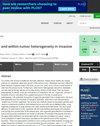肌球蛋白 VI 恢复冲程早期步骤的弱耦合机制:自由能模拟和弦法分析。
IF 3.6
2区 生物学
引用次数: 0
摘要
肌球蛋白马达利用 ATP 的能量通过杠杆臂的摆动在肌动蛋白上产生力和定向运动。在被称为恢复冲程的脱离肌动蛋白再刺激转换过程中,ATP 会被水解。要了解肌球蛋白的化学机械传导,关键是要确定杠杆臂的反向摆动和 ATP 的水解是如何耦合的。以前的研究认为,肌球蛋白 II 的恢复冲程是由核苷酸结合位点开关 II 环的闭合启动的。最近,我们提出肌球蛋白 VI 的恢复冲程始于转换器结构域自发地重新priming 到假定的过渡前状态(PTS)中间体,该中间体先于 Switch II 闭合和 ATP 酶激活。在这里,我们利用几何自由能模拟和弦法研究了肌球蛋白 VI 从恢复前、支撑后(PR)状态到 PTS 的转变。首先,我们的计算以不可知论的方式重新发现了 PTS 状态,并表明它可以通过低自由能过渡路径从 PR 状态进入。其次,利用弦法进行的单独路径计算以原子分辨率阐明了从 PR 到 PTS 的转变机制。在这一机制中,起始事件是转换器/杠杆臂区域的大幅移动,它引发了中继-SH1 区域的重排,并在中继螺旋中形成了与活性位点无耦合的扭结。对路径自由能垒的分析表明,转换器启动的机制比开关 II 关闭启动的机制要快得多,这支持了 PTS 作为肌球蛋白 VI 恢复冲程的主要路径中间体的生物学相关性。我们的分析表明,杠杆臂再刺激和 ATP 水解只是弱耦合,因此肌球蛋白恢复行程是由热波动启动的,并通过类似棘轮的机制由核苷酸消耗稳定下来。本文章由计算机程序翻译,如有差异,请以英文原文为准。
A weak coupling mechanism for the early steps of the recovery stroke of myosin VI: A free energy simulation and string method analysis.
Myosin motors use the energy of ATP to produce force and directed movement on actin by a swing of the lever arm. ATP is hydrolysed during the off-actin re-priming transition termed recovery stroke. To provide an understanding of chemo-mechanical transduction by myosin, it is critical to determine how the reverse swing of the lever arm and ATP hydrolysis are coupled. Previous studies concluded that the recovery stroke of myosin II is initiated by closure of the Switch II loop in the nucleotide-binding site. Recently, we proposed that the recovery stroke of myosin VI starts with the spontaneous re-priming of the converter domain to a putative pre-transition state (PTS) intermediate that precedes Switch II closing and ATPase activation. Here, we investigate the transition from the pre-recovery, post-rigor (PR) state to PTS in myosin VI using geometric free energy simulations and the string method. First, our calculations rediscover the PTS state agnostically and show that it is accessible from PR via a low free energy transition path. Second, separate path calculations using the string method illuminate the mechanism of the PR to PTS transition with atomic resolution. In this mechanism, the initiating event is a large movement of the converter/lever-arm region that triggers rearrangements in the Relay-SH1 region and the formation of the kink in the Relay helix with no coupling to the active site. Analysis of the free-energy barriers along the path suggests that the converter-initiated mechanism is much faster than the one initiated by Switch II closure, which supports the biological relevance of PTS as a major on-pathway intermediate of the recovery stroke in myosin VI. Our analysis suggests that lever-arm re-priming and ATP hydrolysis are only weakly coupled, so that the myosin recovery stroke is initiated by thermal fluctuations and stabilised by nucleotide consumption via a ratchet-like mechanism.
求助全文
通过发布文献求助,成功后即可免费获取论文全文。
去求助
来源期刊

PLoS Computational Biology
生物-生化研究方法
CiteScore
7.10
自引率
4.70%
发文量
820
期刊介绍:
PLOS Computational Biology features works of exceptional significance that further our understanding of living systems at all scales—from molecules and cells, to patient populations and ecosystems—through the application of computational methods. Readers include life and computational scientists, who can take the important findings presented here to the next level of discovery.
Research articles must be declared as belonging to a relevant section. More information about the sections can be found in the submission guidelines.
Research articles should model aspects of biological systems, demonstrate both methodological and scientific novelty, and provide profound new biological insights.
Generally, reliability and significance of biological discovery through computation should be validated and enriched by experimental studies. Inclusion of experimental validation is not required for publication, but should be referenced where possible. Inclusion of experimental validation of a modest biological discovery through computation does not render a manuscript suitable for PLOS Computational Biology.
Research articles specifically designated as Methods papers should describe outstanding methods of exceptional importance that have been shown, or have the promise to provide new biological insights. The method must already be widely adopted, or have the promise of wide adoption by a broad community of users. Enhancements to existing published methods will only be considered if those enhancements bring exceptional new capabilities.
 求助内容:
求助内容: 应助结果提醒方式:
应助结果提醒方式:


